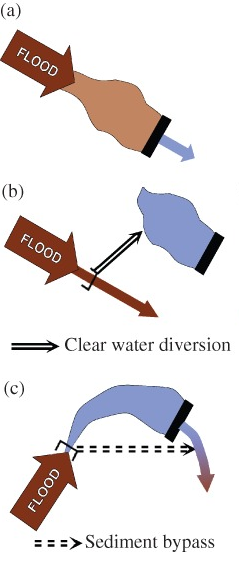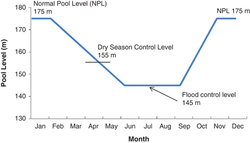Off-channel reservoir storage
Contents
Introduction

Dams act as a barrier for sediment transport in river systems. Sediments-laden inflows bring sediments from upstream catchment that will be trapped when reaching the reservoir. Sediments deposit in the bottom of the reservoir and reduce its storage capacity. In geographical areas with very high sediment concentration, reservoirs can be filled after some years, rendering useless the infrastructure. Consequently, sediments are not transported downstream the dam, resulting in sediment starvation in the downstream river. Lack of sediments can induce severe morphological and ecological impacts.
Off-channel reservoirs, like sediment bypasses, are measures which aim at routing bed-load and part of the suspended sediment load through or around the reservoir (Morris et al. 1998, Kondolf et al. 2014). The objective is to maintain the storage capacity of the reservoir in addition to ensure sediment continuity in the river and avoid morphological and ecological impacts.
A diversion dam or weir is located in the river, allowing diverting of clear water to the reservoir at period of low flow and low sediment loads only, and leaving sediment-laden waters in the river.
Methods, tools, and devices
During planning
Similar to bypass tunnels, off-channel reservoir requires a sufficient gradient in the diversion tunnel to insure flow transport to the reservoir. The design of diversion tunnels to the off-channel reservoir depends on catchment characteristics like topography, geology, hydrology.
The advantage of off-channel reservoirs is that they prevent almost all bed load to enter the reservoir, and do not interfere with sediment continuity required to achieve good ecological status in rivers. However, the amount of water that can be diverted from the river and stored is limited to the flow capacity of the diversion channel. So, this measure is less suited to semi-arid and arid zones with short periods of very intense flows.
During implementation
During sluicing, the reservoir is drawn down at low level. Gates are opened to let high sediment-laden water flow through the reservoir. The success criteria for flushing are:
- low reservoir water level conjointly with high discharge
- low-level gates located close to the bottom of the dam
- steep river bed and straight reservoir bottom slope
- sediments consist of fine material recently deposited.
Concentration of suspended sediments and turbidity levels in the river must be monitored during sluicing operations to ensure that their value remain under ecosystems thresholds and that the operation does not have significant impacts on the physical and chemical environment.
During operation
Concentration of suspended sediments and turbidity levels in the river must be monitored also after sluicing operations to ensure that their value remain under ecosystems thresholds and that the operation does not have significant impacts on the physical and chemical environment. Additionally, monitoring of sediment deposition downstream the dam, including clogging of sediments and the potential impacts on fish shelter and spawning areas needs to be carried out. Such monitoring can help to implement more sustainable sluicing operations.
